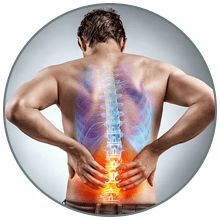Radiofrequency Techniques

CONTACT
If you wish to contact us, to make an appointment or request more information about our services, please do so here
Patient Reviews
After months of intense pain in my back and leg due to a hernia, and after being full of medications and rehabilitation sessions, finally a friend recommended this clinic and I was absolutely right. They visited me very quickly and Dr Ruiz performed a radiofrequency intervention that has solved the problem, it no longer hurts and I have regained my quality of life, which I had lost. I only have words of gratitude
I had a rhizolysis two years ago and it is the best decision I ever made. I was advised to go to this clinic. Excellent staff and treatment. I would come back without hesitation. I am a different person since I don’t feel any pain.
In a frankly desperate situation with my mother suffering from trigeminal neuralgia and with continuous and terrible pain during confinement and no public health doctor able to relieve her pain in any way, it was miraculous to find this center by surfing the internet. In just a couple of weeks after the initial visit, Dr. Ruiz operated on my mother in an outpatient and non-aggressive surgery and in just a few days she regained speech, mobility and finally began to sleep as she no longer suffered the tremendous pain. And if the treatment has been effective thanks to the hands of a great doctor, this does not mean that the whole team at the center is not deserving of credit. From the reception to the nurses, they are all exemplary professionals who make you feel safe and in good hands at all times. My mother is already another and just 4 months later we are aware that there is no better investment than health and Clínica Vértebra is a success. Totally recommendable. THANKS A MILLION.
It has been a long time since I felt what it was like to live without pain. I only have words of gratitude for the whole team, from the reception staff to the operating room team. Thank you Dr. Squarcia for such a detailed explanation of my problem and for the accuracy of the treatment. I pray to God that this wellness lasts for a long time.
I had a lumbar facet denervation (Rhizolysis) this morning and I have to say that «O» pain. It has been 10 hours since the intervention and I am still without any pain and without medication. Congratulations to the whole team. Viggo Adeler (Physician)
Good treatment and attention, I went with a horse sciatica and they left me like new, I only have words of thanks.
It is a place that has improved my quality of life.
I only have words of thanks to Doctors Ricardo Ruiz and Dr. Matias, I have gone to them twice, and I only have words of thanks, they have solved my problem, first of Lumbar vertebrae and the second of a shoulder, and in both cases total success, I have not returned to have any kind of discomfort, I am totally grateful to them, they have changed my life. THANK YOU DOCTORS, you are fantastic.
First visit with Dr. Mattia Squarcia, finally a doctor who listens to me and looks at all my medical tests. I have already had a bad experience with another pain clinic where the doctor did not listen to me and did not even look at a single medical test.
I have only words of thanks, thank you Doctor Ricardo Ruiz.







